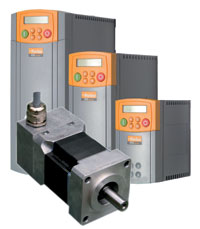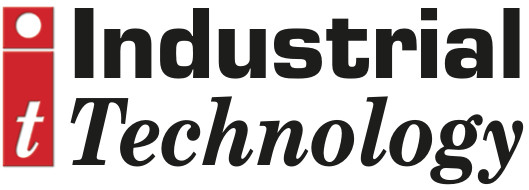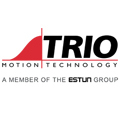
Posted to News on 28th Jan 2011, 00:00
Sensorless vector begins to match servo performance
The traditional boundaries between inverter performance and servo performance are blurring. Andy Parker-Bates of Parker Hannifin SSD Drives Division looks at how close engineers can get with sensorless vector drives can get to true servo performance today, and the advantages of doing so.

As the technology behind variable speed drives marches forward, we often hear phrases such as servo or near-servo performance. What does that actually mean, though? Can we really abandon the cost and perceived complexity of traditional servos for the affordability and simplicity of the best of the modern inverters?
It would be nice if there was a clear-cut yes/no answer to the latter question, but perhaps a slightly better question to ask is how close can we get to servo performance with the most affordable of the near-servo inverter/motor combinations? We are talking about sensorless vector inverters used with standard AC induction motors. And to answer that question, we first need to take a look at the underlying technology.
Let's start with conventional v/f inverters that put out a PWM signal to drive the motor, controlling the speed or torque of the motor by varying the frequency of the electrical power. They meet the needs of a whole range of simple speed control applications where speed needs to be varied, acceleration/deceleration ramps need to be defined, and where some degree of positioning accuracy is desirable. Typical applications might include fans, pumps, conveyors, materials handling, etc.
The drive itself knows nothing about the motor. In the simplest installations, when you dial in a specific speed requirement or torque requirement, the drive is doing little more than taking an educated guess. Often that's good enough. If not, then it can derive some intelligence from process feedback. But it's certainly nowhere near servo performance - and neither does it pretend to be.
When we talk about servo performance, then generally we are talking about highly dynamic motion with fast accelerations and decelerations, extremely accurate positioning, and often many axes of synchronised motion. This is a far cry from the capability of the standard v/f drive. But with vector control, we can begin to close the gap. Vector control begins with the drive storing in memory a map of the motor's performance characteristics. The drive then monitors both the inductive current and the torque current in the motor. The vectors of these currents are 90 degrees apart. The drive controls the motor by monitoring these vector currents, comparing them with the motor map, and sending an appropriate PWM signal to control the motor. As soon as any deviation is detected in one of the vector currents from the stored map, the drive acts to correct the deviation and keep the motor under precise control.
Within vector control there are both open loop and closed loop strategies. A closed loop vector drive adds a shaft encoder to the motor to provide position feedback. To date, when we have talked about inverters offering near-servo performance, it is closed loop vector drives we have been referring to. But what about open loop vector drives, or sensorless vector drives as they are more commonly known? Although they dispense with the motor shaft encoder, calling them open loop is something of a misnomer since they are still monitoring motor currents, comparing them with the vector map and adjusting the PWM output accordingly. There is feedback - direct feedback from the motor - so it is still a closed loop system, but there is no external physical feedback sensor.
Complex algorithms
The ultimate performance of vector control drives generally and sensorless vector drives in particular is highly dependent of the embedded microprocessor, and this is where things start to get interesting when we discuss inverters getting close the matching the capabilities of servos. It all comes down to reaction speed. The vector drive is doing some pretty complex mathematics to map the inductive current and torque current with the stored vector map, make any adjustments to the PWM output, and then compare what changes those adjustments have made compared with the map. The algorithms involved require a lot of processing power and a high processing speed.
For true servo performance in the most dynamic applications, the required response time is often measured in tiny fractions of a second, and the motor may have to perform a complex acceleration/deceleration/positioning sequence in a duty cycle that itself may only last a few milliseconds. Until very recently, that sort of performance was way beyond even the very best vector controllers.
The performance of a vector controlled drive system is dependent on the speed and accuracy with which current components can be identified and acted upon within the microprocessor. But the rapid advances in microprocessor technology mean that the calculations behind the vector algorithms are being performed ever faster, with the result that the boundaries really are blurring between vector control performance and servo performance.
It probably isn't appropriate these days to talk about servo systems being so complex to tune that they required a servo expert. Modern systems guide the user through set up and operation much the way an inverter does. But certainly there is still a huge cost differential. Servo motors are expensive beasts, partly due to the use of rare earth magnets and partly down to the fact that they are not manufactured in anything like the volumes of induction motors. Servo drives, too, are typically more expensive than vector drives. There is the cost of the feedback device to consider as well.
These are all benefits for sensorless vector drives. The drive itself costs little more than a much more mundane v/f drive, the induction motors - as discussed - a low cost, volume produced units, and there is no need for a shaft encoder. The cost advantage is significant - a gap that remains large even while the performance gap is closing. In addition, true servo systems are limited in power, and quickly become cost prohibitive as power requirements increase. Further, today's sensorless vector drives don't necessarily restrict users to induction motors: they can be used with permanent magnet motors to reap even higher performance - another step closer to full servo systems - while still maintaining a significant cost advantage. And even the increase in price over a standard induction motor can quickly be recouped through the energy savings of a higher efficiency permanent magnet motor.
The range of servo applications covers a broad spectrum of performance requirements, from the highly dynamic and highly demanding to the less strenuous, less critical. Certainly sensorless vector isn't yet quite a match for full servo at the very highest end, but there is no doubt that it is rapidly encroaching on traditional servo applications from the bottom up, providing engineers with an optimum match of cost against performance. And as microprocessor technology continues its rapid advance, the gap at the top is only going to get smaller.
Electromechanical Drives Business Unit
New Courtwick Lane
BN17 7PD
UNITED KINGDOM
01903 737000







